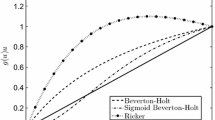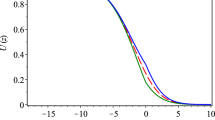Abstract
Individual variability in dispersal and reproduction abilities can lead to evolutionary processes that may have significant effects on the speed and shape of biological invasions. Spatial sorting, an evolutionary process through which individuals with the highest dispersal ability tend to agglomerate at the leading edge of an invasion front, and spatial selection, spatially heterogeneous forces of selection, are among the fundamental evolutionary forces that can change range expansions. Most mathematical models for these processes are based on reaction-diffusion equations, i.e., time is continuous and dispersal is Gaussian. We develop novel theory for how evolution shapes biological invasions with integrodifference equations, i.e., time is discrete and dispersal can follow a variety of kernels. Our model tracks how the distribution of growth rates and dispersal ability in the population changes from one generation to the next in continuous space. We include mutation between types and a potential trade-off between dispersal ability and growth rate. We perform the analysis of such models in continuous and discrete trait spaces, i.e., we determine the existence of travelling wave solutions, asymptotic spreading speeds and their linear determinacy, as well as the population distributions at the leading edge. We also establish the relation between asymptotic spreading speeds and mutation probabilities. We observe conditions for when spatial sorting emerges and when it does not and also explore conditions where anomalous spreading speeds occur, as well as possible effects of deleterious mutations in the population.








Similar content being viewed by others
Notes
Note that a more subtle definition of an anomalous spreading speed was first given by Weinberger et al. (2007). An anomalous speed in their sense can only occur when the linearized operator is reducible and system is not linearly determined. Our model does not fall under their definition.
References
Alfaro M, Coville J, Raoul G (2013) Travelling waves in a nonlocal reaction-diffusion equation as a model for a population structured by a space variable and a phenotypic trait. Comm Partial Differ Equ 38(12):2126–2154
Alfaro M, Berestycki H, Raoul G (2017) The effect of climate shift on a species submitted to dispersion, evolution, growth, and nonlocal competition. SIAM J Math Anal 49(1):562–596
Alfaro M, Girardin L, Hamel F, Roques L (2021) When the Allee threshold is an evolutionary trait: persistence vs. extinction. J Math Pures Appl 155:155–191
Altenberg L (2012) Resolvent positive linear operators exhibit the reduction phenomenon. Proc Natl Acad Sci 109(10):3705–3710
Bouin E, Calvez V, Meunier N, Mirrahimi S, Perthame B, Raoul G, Voituriez R (2012) Invasion fronts with variable motility: phenotype selection, spatial sorting and wave acceleration. CR Math 350(15):761–766. https://doi.org/10.1016/j.crma.2012.09.010
Bouin E, Chan MH, Henderson C, Kim PS (2018) Influence of a mortality trade-off on the spreading rate of cane toads fronts. Comm Partial Differ Equ 43(11):1627–1671
Bourgeois A, LeBlanc V, Lutscher F (2018) Spreading phenomena in integrodifference equations with nonmonotone growth functions. SIAM J Appl Math 78(6):2950–2972
Britton NF (1990) Spatial structures and periodic travelling waves in an integro-differential reaction-diffusion population model. SIAM J Appl Math 50(6):1663–1688
Brown GP, Shilton C, Phillips BL, Shine R (2007) Invasion, stress, and spinal arthritis in cane toads. Proc Natl Acad Sci 104(45):17698–17700
Bullock JM, Clarke RT (2000) Long distance seed dispersal by wind: measuring and modelling the tail of the curve. Oecologia 124(4):506–521
Burton OJ, Phillips BL, Travis JM (2010) Trade-offs and the evolution of life-histories during range expansion. Ecol Lett 13(10):1210–1220
Caswell H (2000) Matrix population models, vol 1. Sinauer, Sunderland
Clarke GS, Shine R, Phillips BL (2019) May the (selective) force be with you: spatial sorting and natural selection exert opposing forces on limb length in an invasive amphibian. J Evol Biol 32(9):994–1001
Cohen JE (1981) Convexity of the dominant eigenvalue of an essentially nonnegative matrix. Proc Am Math Soc 81(4):657–658
Cosner C (2014) Reaction-diffusion-advection models for the effects and evolution of dispersal. Discrete Contin Dyn Syst 34(5):1701
Doebeli M (1996) A quantitative genetic competition model for sympatric speciation. J Evol Biol 9(6):893–909
Elliott EC, Cornell SJ (2012) Dispersal polymorphism and the speed of biological invasions. PLoS ONE 7(7):40496
Ellner SP, Childs DZ, Rees M et al (2016) Data-driven modelling of structured populations. A practical guide to the integral projection model. Springer, Cham
Fisher RA (1937) The wave of advance of advantageous genes. Ann Eugen 7(4):355–369
Fuentes M, Kuperman M, Kenkre V (2003) Nonlocal interaction effects on pattern formation in population dynamics. Phys Rev Lett 91(15):158104
Griette Q (2019) Singular measure traveling waves in an epidemiological model with continuous phenotypes. Trans Am Math Soc 371(6):4411–4458
Hastings A (1983) Can spatial variation alone lead to selection for dispersal? Theor Popul Biol 24(3):244–251
Karlin S (1982) Classifications of selection-migration structures and conditions for a protected polymorphism. Evol Biol 14(61):204
Karlin S, McGregor J (1974) Towards a theory of the evolution of modifier genes. Theor Popul Biol 5(1):59–103
Keenan VA, Cornell SJ (2021) Anomalous invasion dynamics due to dispersal polymorphism and dispersal-reproduction trade-offs. Proc R Soc B 288(1942):20202825
Kingman JF (1978) A simple model for the balance between selection and mutation. J Appl Probab 15(1):1–12
Kolmogorov A, Petrovsky L, Piskunov N (1937) An investigation of the diffusion equation combined with an increase in mass and its application to a biological problem. Bull Uni Mosc Ser Int A 1(6):1–26
Krein MG, Rutman MA (1948) Linear operators leaving invariant a cone in a Banach space. Uspekhi Mat Nauk 3(1):3–95
Lewis MA, Petrovskii SV, Potts JR (2016) The mathematics behind biological invasions, vol 44. Springer, New York
Liang X, Zhao X-Q (2007) Asymptotic speeds of spread and traveling waves for monotone semiflows with applications. Commun Pure Appl Math J Issued Courant Inst Math Sci 60(1):1–40
Lowry E, Rollinson EJ, Laybourn AJ, Scott TE, Aiello-Lammens ME, Gray SM, Mickley J, Gurevitch J (2013) Biological invasions: a field synopsis, systematic review, and database of the literature. Ecol Evol 3(1):182–196
Lui R (1989) Biological growth and spread modeled by systems of recursions. I. Mathematical theory. Math Biosci 93(2):269–295
Lutscher F (2019) Integrodifference equations in spatial ecology. Springer, New York
Lutscher F, Popovic L, Shaw AK (2022) How mutation shapes the rate of population spread in the presence of a mate-finding Allee effect. Theor Ecol. https://doi.org/10.1007/s12080-022-00540-2
Marculis NG, Evenden ML, Lewis MA (2020) Modeling the dispersal-reproduction trade-off in an expanding population. Theor Popul Biol 134:147–159
May RM (2019) Stability and complexity in model ecosystems. Princeton University Press, Princeton
Miller TE, Shaw AK, Inouye BD, Neubert MG (2011) Sex-biased dispersal and the speed of two-sex invasions. Am Nat 177(5):549–561
Miller TE, Angert AL, Brown CD, Lee-Yaw JA, Lewis M, Lutscher F, Marculis NG, Melbourne BA, Shaw AK, Szűcs M et al (2020) Eco-evolutionary dynamics of range expansion. Ecology 101(10):03139
Morris A, Börger L, Crooks E (2019) Individual variability in dispersal and invasion speed. Mathematics 7(9):795. https://doi.org/10.3390/math7090795
Neubert MG, Caswell H (2000) Demography and dispersal: calculation and sensitivity analysis of invasion speed for structured populations. Ecology 81(6):1613–1628
Phillips BL, Perkins TA (2019) Spatial sorting as the spatial analogue of natural selection. Thyroid Res 12(2):155–163
Phillips BL, Brown GP, Travis JM, Shine R (2008) Reid’s paradox revisited: the evolution of dispersal kernels during range expansion. Am Nat 172(S1):34–48
Schreiber SJ, Beckman NG (2020) Individual variation in dispersal and fecundity increases rates of spatial spread. AoB Plants 12(3):001
Shine R, Brown GP, Phillips BL (2011) An evolutionary process that assembles phenotypes through space rather than through time. Proc Natl Acad Sci 108(14):5708–5711
Stover JP, Kendall BE, Nisbet RM (2014) Consequences of dispersal heterogeneity for population spread and persistence. Bull Math Biol 76(11):2681–2710
Thieme HR (1979) Density-dependent regulation of spatially distributed populations and their asymptotic speed of spread. J Math Biol 8(2):173–187
Thieme HR (2009) Spectral bound and reproduction number for infinite-dimensional population structure and time heterogeneity. SIAM J Appl Math 70(1):188–211
Weinberger HF (1982) Long-time behavior of a class of biological models. SIAM J Math Anal 13(3):353–396
Weinberger HF, Lewis MA, Li B (2002) Analysis of linear determinacy for spread in cooperative models. J Math Biol 45(3):183–218
Weinberger HF, Lewis MA, Li B (2007) Anomalous spreading speeds of cooperative recursion systems. J Math Biol 55:207–222
Acknowledgements
SP is funded by São Paulo Research Foundation, FAPESP (grants 2018/24037-4 and 2020/15320-4). FL is funded by Natural Sciences and Engineering Research Council of Canada (RGPIN-2016-0495). We thank Fields Institute for funding and organizing the “Workshop on New Mathematical Theory to Understand the Effects of Evolution on Range Expansion”, this work benefited from the event and discussions therein. We thank Thomas Hillen for inspiring discussions. We thank two anonymous reviewers and also the handling editor, Sebastian Schreiber, for their suggestions and corrections to the text.
Author information
Authors and Affiliations
Contributions
Both authors contributed equally to conceptualizing the study and to writing and editing the manuscript. SP led the analysis and the numerical simulations.
Corresponding author
Additional information
Publisher's Note
Springer Nature remains neutral with regard to jurisdictional claims in published maps and institutional affiliations.
Rights and permissions
Springer Nature or its licensor (e.g. a society or other partner) holds exclusive rights to this article under a publishing agreement with the author(s) or other rightsholder(s); author self-archiving of the accepted manuscript version of this article is solely governed by the terms of such publishing agreement and applicable law.
About this article
Cite this article
Poloni, S., Lutscher, F. Integrodifference models for evolutionary processes in biological invasions. J. Math. Biol. 87, 10 (2023). https://doi.org/10.1007/s00285-023-01947-z
Received:
Revised:
Accepted:
Published:
DOI: https://doi.org/10.1007/s00285-023-01947-z
Keywords
- Spatial spread
- Spatial sorting
- Trait-structured populations
- Dispersal evolution
- Dispersal-reproduction trade-off




